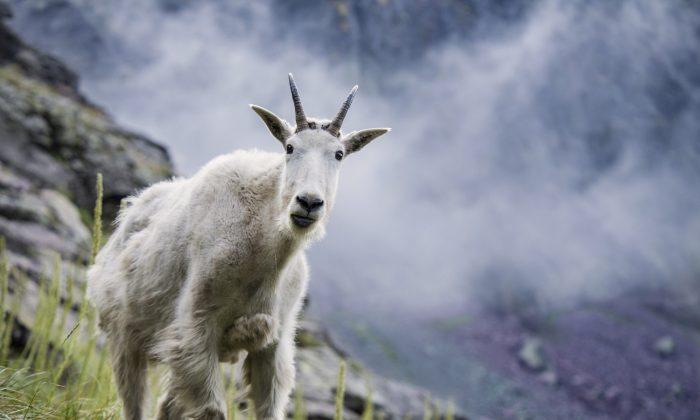Concern has peaked surrounding the Rocky Mountain Goat and its increasingly aggressive behavior and environmental impact in Olympic National Park, Washington State.
In Olympic National Park, the mountain goats have no problem approaching and even chasing park visitors—they have learnt this may lead to a reward despite National Parks advice against feeding and interacting with the animals. Now, the unabashed goats and their aggressive behavior is again causing problems for park management.
Officials at the national park are again facing a delicate balancing act to determine life or death for these reigning kings and queens of the mountain.
In 2010, a hiker died from a goat attack. The hiker was protecting his wife and a friend from the aggressive goat, but was fatally gored as he tried to move it out of the area. The goat had severed some arteries in his thigh and stood over his body, delaying medical assistance, reported the Seattle Times.
New guidelines were introduced following the fatal incident, and in 2011, park officers shot and killed a goat that was behaving aggressively in a camping area, according to an AP report.
Mountain goats are often attracted to people and campsites, craving the minerals and salt that is lacking in their alpine environment. They have learned to find it in sweat on backpacks, clothing, and reportedly, urine.
It seems that the goats are wearing out their welcome as park visitors discover that their yelling, waving arms or clothing, or throwing rocks—as advised by the National Parks Service—leaves the goats increasingly undeterred.
The National Parks Service, in cooperation with the U.S. Forest Service and Washington Department of Fish and Wildlife, released an environmental-impact statement on July 24 in which it recommended three management options. The first option was the capture and relocation of the goats to the North Cascades national forests, although the process has faced challenges in the past due to shock and injury of animals, and concern over staff safety in the rugged terrain. Helicopter culling was presented as a second option. The third option, favored by park officials, involves a combination of both: capturing as many goats as possible, and shooting those too difficult to be caught.
According to Louise Johnson, the park’s chief of resources management, relocation work is highly involved and would take years, reported NPR.
Olympic National Park has seen numerous attempts at goat population control. The Rocky Mountain Goats (Oreamnos americanus) are not native to the Olympic Peninsula, although they are found throughout the surrounding Rocky ranges. It is estimated that there are between 2,400 and 3,200 mountain goats in Washington State.
![Distribution of the Rocky Mountain Goat, Oreamnos americanus.<br/>(Ninjatacoshell [CC BY-SA 2.5 (http://creativecommons.org/licenses/by-sa/2.5)], via Wikimedia Commons)](/_next/image?url=https%3A%2F%2Fwww.theepochtimes.com%2Fassets%2Fuploads%2F2017%2F08%2F05%2F2000px-Oreamnos_americanus_distribution.svg_-674x811.png&w=1200&q=75)
(Ninjatacoshell [CC BY-SA 2.5 (http://creativecommons.org/licenses/by-sa/2.5)], via Wikimedia Commons)
A dozen goats from native populations in the nearby Cascade Range were introduced to the area in the 1920s in the hopes of establishing a hunting population, according to the Seattle Times. But since hunting was banned in 1939 as the national park was established, and the goat population expanded to more than 1,100 by 1983 when the first talk of population control began.
As an introduced species, the goats have also caused significant damage, as the sensitive alpine vegetation isn’t adapted to tolerate their grazing behavior. “It was just the wrong thing to do,” Johnson told NPR. They eat everything in sight and have caused the loss of many native plants due to their wallowing behavior. “That has had the effect of denuding large areas of sensitive native plants,” Johnson explains.
Around half of the goat population was captured and removed from the park during the 1980s by park officials, but the program was unsustainable due to concerns for staff safety. But by 1995, the officials were again considering how to reduce goat numbers, with talks of helicopter culling, but no action was taken due to the outcry from animal rights supporters.
According to NPR, more than 600 goats now roam the park, with the population growing about 8 percent every year.
Jim Matthews discussed on Daily Press one alternative plan of action that was dismissed in the environmental impact statement—perhaps because it involves Federal legislation regarding the hunting ban in National Parks.
He noted that the native populations of mountain goats in the nearby Cascade Mountains were not causing the same environmental degradation as they were in Olympic National Park, as hunting—managed under the Washington Department of Fish and Wildlife—was keeping the goat population in check.
“A goat hunting program would solve all the goat problems on the Olympic National Park—and instead of costing money, it would make money for the National Park Service and state of Washington,” claims Matthews.
It is estimated the program to relocate the mountain goats to the Cascade Mountains will cost at least $1.6 million.
Park officials say action is needed in order to reduce the environmental impact and ensure public safety as goat numbers continue to increase.
Currently, altercations between man and wild are managed on a case-by-case basis. Officials attempt to use aversive conditioning to deter aggressive goats from areas of high foot traffic; dangerous goats are killed.
Park officials are hosting open houses on the environmental impact statement, including one at the Seattle Public Library at 5 p.m. Aug. 17.
Members of the public are welcome to comment on the park’s mountain goat management plan—submissions close Sept. 26. A final decision from the regional director for the National Parks Service is expected in Spring 2018.





